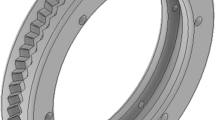Abstract
This paper proposes a novel multi-wound differential pulley winch (MWDPW) component for assisting the ascending/descending operations of a wall climbing robot. The robotic platform enabling rope access in dangerous environments (ROPE RIDE) climbs vertical walls using a rope and embedded winch. The original winch installed on the ROPE RIDE was a single wound winch, which had problems such as rope slip, velocity ripple during descending motion, resulting the bad cleaning performance and unstable motion on the wall. These problems are mainly due to the concentration of traction force on the rope because a small portion of the winch pulley holds the entire weight of the robot. Therefore, we have developed a new winch, MWDPW, by using multi-wound differential traction pulley and pressure rollers to solve the traction force concentration problem by distributing the traction force along the entire wrapping angle. Compared to other multi-wound winches, the MWDPW has the special feature of a differential gear and pressure roller to distribute the traction force and minimize the rope slip. The tension of the MWDPW is analyzed using the basic capstan equation, and empirical results to minimize the rope slip are presented by varying design parameters such as the winding method and presence of the pressure rollers. We expect the proposed mechanism to improve the safety of a wall-climbing robot for wall-cleaning operations.












Similar content being viewed by others
References
Seo, T., Jeon, Y., Park, C., & Kim, J. (2019). Survey on glass and facade cleaning robots: Climbing mechanisms, cleaning methods, and applications. International Journal of Precision Engineering and Manufacturing-Green Technology,6(2), 367–376.
Liu, Y., & Seo, T. (2018). AnyClimb-II: Dry-adhesive linkage-type climbing robot for uneven vertical surfaces. Mechanism and Machine Theory,124, 197–210.
Lee, G., Kim, H., Seo, K., Kim, J., Sitti, M., & Seo, T. (2016). Series of multilinked caterpillar track-type climbing robots. Journal of Field Robotics,33(6), 737–750.
Lee, C., & Chu, B. (2019). Three-modular obstacle-climbing robot for cleaning windows on building exterior walls. International Journal of Precision Engineering and Manufacturing,20(8), 1371–1380.
Seo, K., Cho, S., Kim, T., Kim, H. S., & Kim, J. (2013). Design and stability analysis of a novel wall-climbing robotic platform (ROPE RIDE). Mechanism and Machine Theory,70, 189–208.
Kim, T., Jeon, Y., Yoo, S., Kim, K., Kim, H. S., & Kim, J. (2017). Development of a wall-climbing platform with modularized wall-cleaning units. Automation in Construction,83, 1–18.
Anderson, F. (1986). U.S. Patent No. 4,595,173. Washington, DC: U.S. Patent and Trademark Office.
Ball, N., Fofonoff, T., Schmid, B., & Walker, D. (2007). U.S. Patent No. 7,261,278. Washington, DC: U.S. Patent and Trademark Office.
Shafi, M. S., Lu, J., Song, Z., & Fu, Y. (2015). Design and tension control of double drum Winch system for deep-sea exploration equipment. In Proceedings of the 5th International Conference on Information Engineering for Mechanics and Materials.
Blanc, M. R. (2007). U.S. Patent No. 7,175,163. Washington, DC: U.S. Patent and Trademark Office.
McKenna, H. A. (1976). U.S. Patent No. 3,966,170. Washington, DC: U.S. Patent and Trademark Office.
Torben, S. R., Ingeberg, P., Bunes, Ø., Bull, S., Paterson, J., & Davidson, D. (2007). Fiber rope deployment system for ultradeepwater installations. In Offshore Technology Conference.
Capstone equation. Retrieved July 9, 2018, from https://en.wikipedia.org/wiki/Capstan_equation.
Baser, O., & Konukseven, E. I. (2010). Theoretical and experimental determination of capstan drive slip error. Mechanism and Machine Theory,45(6), 815–827.
Jung, J. H., Kang, T. J., & Youn, J. R. (2004). Effect of bending rigidity on the capstan equation. Textile Research Journal,74(12), 1085–1096.
Leamy, M. J., & Wasfy, T. M. (2002). Analysis of belt-driven mechanics using a creep-rate-dependent friction law. Journal of Applied Mechanics, Transactions of ASME,69(6), 763–771.
Acknowledgements
This research was supported by the National Research Foundation of Korea (NRF) Grant funded by the Ministry of Science and ICT for First-Mover Program for Accelerating Disruptive Technology Development [NRF-2018M3C1B9088328(2018M3C1B9088331, 2018M3C1B9088332)].
Author information
Authors and Affiliations
Corresponding authors
Additional information
Publisher's Note
Springer Nature remains neutral with regard to jurisdictional claims in published maps and institutional affiliations.
Rights and permissions
About this article
Cite this article
Yoo, S., Joo, I., Hong, J. et al. Mechanical and Empirical Parameter Design on a Multi-wound Differential Pulley Winch for a Wall-Climbing Robot. Int. J. Precis. Eng. Manuf. 21, 857–867 (2020). https://doi.org/10.1007/s12541-019-00281-z
Received:
Revised:
Accepted:
Published:
Issue Date:
DOI: https://doi.org/10.1007/s12541-019-00281-z




